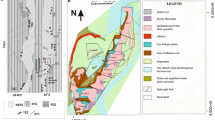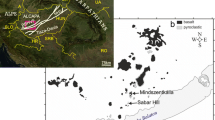Abstract
The emerald mineralization in the Habachtal (Austria) is geologically and tectonically complex, and previous investigators have identified fluid inclusion evidence for a hydrothermal/metamorphic origin for the emeralds. In this paper we report the discovery of emeralds with a distinctly different inclusion population including melt inclusions, which demonstrates that at least some and probably most of the emerald mineralization in the Habachtal occurred from an extremely fluid-rich pegmatite-like aluminosilicate melt under supercritical conditions, at high temperatures and moderate pressures (~700 °C, 5 kbar). This conclusion is based on the presence of very highly-ordered graphite, and extremely water-rich melt inclusions in emerald. The Lorentz distribution of MgCO3 against the water concentration is a very robust proof for the supercritical state. We suggest that the purely metamorphic model, based on the extrapolation of fluid inclusion data to the regional metamorphic conditions (550 °C and 5 kbar) by some previous investigators are inconsistent with our finding of high-temperature indications (well-ordered graphite, high-temperature fluid inclusions and melt inclusions). This apparent conflict suggests a more complex situation and requires a re-investigation of the emerald genesis in the Habachtal deposit.







Similar content being viewed by others
References
Akizuki M (1965) Splitting of liquid inclusions in a potassium alum crystal. Sci Rep Tohoku Univ, Series 3 IX(2):371–376
Aoya M, Kouketsu Y, Endo S, Shimizu H, Mizukami T, Nakamura D, Wallis S (2010) Extending the applicability of the Raman carbonaceous-material geothermometer using data from contact metamorphic rocks. J Metamorph Geol 28:895–914
Barrenechea JF, Luque FJ, Millward D, Ortega L, Beyssac O, Rodas M (2009) Graphite morphologies from Borrowdale deposit (NW England, UK): Raman and SIMS data. Contrib Mineral Petrol 158:37–51
Beyssac O, Coffé B, Chopin C, Rouzaud JN (2002) Raman spectra of carbonaceous material in metasediments: a new geothermometer. J metamorphic Geol 20:859–871
Beyssac O, Lazzeri M (2012) Application of Raman spectroscopy to the study of graphitic carbons in the earth sciences. EMU Notes Mineral 12(12):415–454
Calligaro T, Dran JC, Poirot JP, Querré G, Salomon J, Zwaan JC (2000) PIXE/PIGE characterization of emeralds using an external micro-beam. Nucl Inst Methods Phys Res B 161–163:769–774
Dissanayake CB (1981) The origin of graphite of Sri Lanka. Org Geochem 3:1–7
Fersmann A (1929) Smaragdgruben im Uralgebirge. In: Geochemische Migration der Element, Teil 1. Abh prakt Geol und Bergwirtschaftslehre 18(3):74–116
Franz G, Morteani G (2002) Be-Minerals: Synthesis, stability, and occurrence in metamorphic rocks. In: Beryllium – Mineralogy, Petrology, and Geochemistry. Ed. by E.S. Grew. Chapter 13. Rev Mineral Geochem Vol. 50, Miner Soc Amer: 551–589
Franz G, Grundmann G, Ackermand D (1986) Rock forming Beryl from a regional metamorphic terrain (Tauern window, Austria): Paragenesis and crystal chemistry. Tschermaks Miner Petrogr Mitt 35:167–192
Giuliani G, Groat LA, Marshall D, Fallick AE, Branquet Y (2019) Emerald deposits: a review and enhanced classification. Minerals 9(2):105:1–105:10563
Gmelin L (1930) Gmelins Handbuch der anorganischen Chemie, System No. 26 Beryllium, Verlag Chemie, Berlin, 180 pp
Grew ES (1974) Carbonaceous material in some metamorphic rocks of New England and other areas. J Geol 82:50–73
Groat LA, Giuliani G, Marshall DD, Turner D (2008) Emerald deposits and occurrences: a review. Ore Geol Rev 34:87–112
Grundmann G (1983) Die Genesis der regionalmetamorphen, metasomatisch-horizontgebundenen Beryll-Mineralisationen des Habachtales, Land Salzburg, Österreich. Dissertation D 83, Technische Universität Berlin, 208 pp
Grundmann G, Morteani G (1982) Die Geologie des Smaragdvorkommens im Habachtal (Land Salzburg, Österreich) Archiv für Lagerstättenforschung Geol Bundesanst 2:71–107
Grundmann G, Morteani G (1989) Emerald mineralization during regional metamorphism: the Habachtal (Austria) and Leydsdorp (Transvaal, South Africa) deposits. Econ Geol 84:1835–1849
Gübelin EJ, Koivula JI (1986) Bildatlas der Einschlüsse in Edelsteinen. ABC Verlag Zürich, 532 pp
Hack AC, Thompson AB, Aerts M (2007) Phase relations involving hydrous silicate melts, aqueous fluids, and minerals. Rev Mineral Geochem 65:129–185
Holleman AF, Wiberg N (2007) Lehrbuch der Anorganischen Chemie, 102th edition. Walter de Gruyter, Berlin and New York, 2149 pp
Huang J, Hao J, Huang F, Sverjensky D.A. (2019) Mobility of chromium in high temperature crustal and upper mantle fluids. Geochemical Perspectives Letters 12:1–6
Hurai V, Hurai M, Slobodník M, Thomas R. (2015) Geofluids, Elsevier, 489 pp
Lafuente B, Downs RT, Yang H, Stone N (2015) The power of databases: the RRUFF project. In: Armbruster T, Danisi RM (eds) Highlights in mineralogical crystallography. W. De Gruyter, Berlin, pp 1–30
Leitmeier H (1937) Das Smaragdvorkommen im Habachtal in Salzburg und seine Minerale. Miner Petrogr Mitt 49:245–368
Luckscheiter B, Morteani G (1980) Microthermometrical and chemical studies of fluid inclusions in minerals from Alpine veins from the penninic rocks of the central and western Tauern window (Austria/ltaly). Lithos 13:61–77
Marshall DD, Groat LA, Falck H, Giuliani G, Neufeld H (2004) The Lened emerald prospect, Northwest Territories, Canada: insights from fluid inclusions and stable isotopes, with implications for northern cordilleran emeralds. Can Mineral 42:1523–1539
Newkirk HW, Smith DK (1965a) Studies on the formation of crystalline synthetic bromellite. I. Microcrystals. Am Mineral 50:22–43
Newkirk HW, Smith DK (1965b) Studies on the formation of crystalline synthetic bromellite. II. Macrocrystals. Am Mineral 50:44–72
Nwe YY, Grundmann G (1990) Evolution of metamorphic fluids in shear zones: the record from the emeralds of Habachtal, Tauern window, Austria. Lithos 25:281–304
Roedder E (1984) Fluid Inclusions. Reviews in Mineralogy Vol. 12, Miner Soc Amer: 644 pp.
Schenk P, Höll R, Ivanova GF, Naumov VB, Kopneva LA (1990) Fluid inclusion studies of the Felbertal scheelite deposit. Geol Rundsch 79:451–466
Schneiderhöhn H (1961) Die Pegmatite. Stuttgart, 720 pp
Shengelia DM, Akhvlediani RA, Ketskhoveli DN (1979) The graphite geothermometer. Doklady Akad Nauk SSSR, Vol. 235(3):132–134 (Translation of the Russian original contribution, published in 1977)
Thomas R (2000) Determination of water contents of granite melt inclusions by confocal laser Raman microprobe spectroscopy. Am Mineral 85:868–872
Thomas R, Davidson P (2010) Hambergite-rich melt inclusions in morganite crystals from the Muiane pegmatite, Mozambique and some remarks on the paragenesis of hambergite. Mineral Petrol 100:227–239
Thomas R, Davidson P (2012) Water in granite and pegmatite-forming melts. Ore Geol Rev 46:32–46
Thomas R, Davidson P (2016) Revisiting complete miscibility between silicate melts and hydrous fluids, and the extreme enrichment of some elements in the supercritical state – consequences for the formation of pegmatites and ore deposits. Ore Geol Rev 72:1088–1101
Thomas R, Davidson P, Appel K (2019) The enhanced element enrichment in the supercritical states of granite-pegmatite systems. Acta Geochim 38:335–349
Thomas R, Davidson P, Badanina E (2009a) A melt and fluid inclusion assemblage in beryl from pegmatite in the Orlovka amazonite granite, east Transbaikalia, Russia: implications for pegmatite-forming melt systems. Mineral Petrol 96:129–140
Thomas R, Davidson P, Beurlen H (2012) The competing models for the origin and internal evolution of granite pegmatites in the light of melt and fluid inclusion research. Miner Petrol 106:55–73
Thomas R, Kamenetsky VS, Davidson P (2006) Laser Raman spectroscopic measurements of water in unexposed glass inclusions. Am Mineral 91:467–470
Thomas SM, Koch-Müller M, Reichart P, Rhede D, Thomas R, Wirth R, Matsyuk S (2009b) IR calibration for water determination in olivine, r-GeO2, and SiO2 polymorphs. Phys Chem Minerals 36:489–509
Thomas R, Rericha A, Pohl WL, Davidson P (2018) Genetic significance of the 867 cm−1 out-of-plane Raman mode in graphite associated with V-bearing green grossular. Mineral Petrol 112:633–645
Thomas R, Webster JD, Heinrich W (2000) Melt inclusions in pegmatite quartz: complete miscibility between silicate melts and hydrous fluids at low pressure. Contrib Mineral Petrol 139:394–401
Trumbull RB, Krienitz M-S, Grundmann G, Wiedenbeck M (2009) Contrib Mineral Pertrol 157:411–427
Watenphul A, Schmidt C, Jahn S (2014) Cr(III) solubility in aqueous fluids at high pressures and temperatures. Geochim Cosmochim Acta 126:212–227
Wopenka B, Pasteris JD (1993) Structural characterization of kerogens to granulite-facies graphite: applicability of Raman microprobe spectroscopy. Am Mineral 78:533–557
Zwaan JC (2006) Gemology, geology and origin of the Sandawana emerald deposits. Zimbabwe Scripta Geologica 131:211 pp
Acknowledgments
Emerald and beryl samples from Habachtal, Orlovka, Lened, and Yacopi were kindly made available by Lois and Andreas Steiner (Brambach, Austria), Elena Badanina (St. Petersburg, Russia), Dan Marshall (Burnaby, Canada), and Volker Lüders (Potsdam/Germany). We thank Uwe Dittmann (GeoForschungsZentrum Potsdam) for the rapid preparation of a new and well-characterized emerald sample in biotite schist from the Habachtal emerald deposit. Extensive discussion with Günter Grundmann, Robert (Bob) Trumbull, and Johann Raith led to the clarification of some open questions. We thank reviewers Gaston Giuliani and JC (Hanco) Zwaan, and associate editor Anton Beran for valuable remarks on the manuscript.
Author information
Authors and Affiliations
Corresponding author
Additional information
Editorial handling: A. Beran
Publisher’s note
Springer Nature remains neutral with regard to jurisdictional claims in published maps and institutional affiliations.
Rights and permissions
About this article
Cite this article
Thomas, R., Davidson, P. & Rericha, A. Emerald from the Habachtal: new observations. Miner Petrol 114, 161–173 (2020). https://doi.org/10.1007/s00710-020-00700-4
Received:
Accepted:
Published:
Issue Date:
DOI: https://doi.org/10.1007/s00710-020-00700-4




